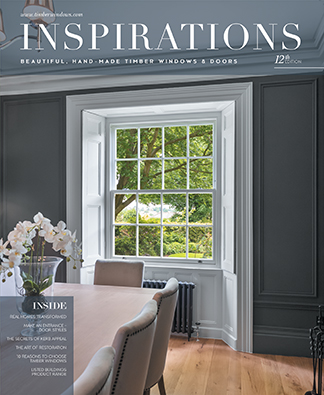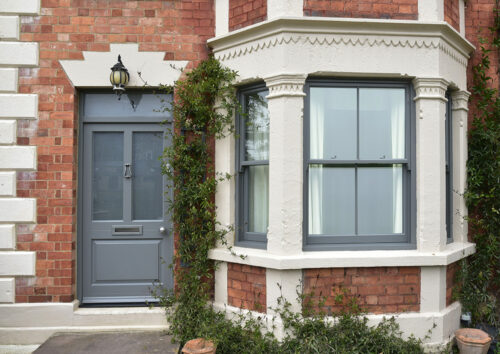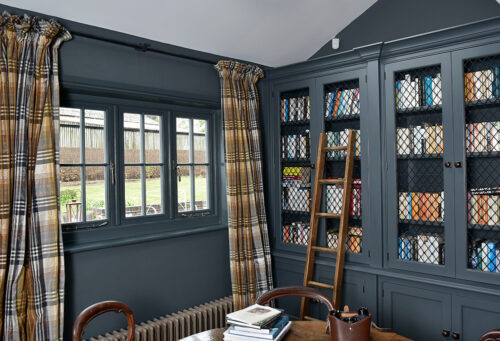Choosing the colour of your new windows – What to consider
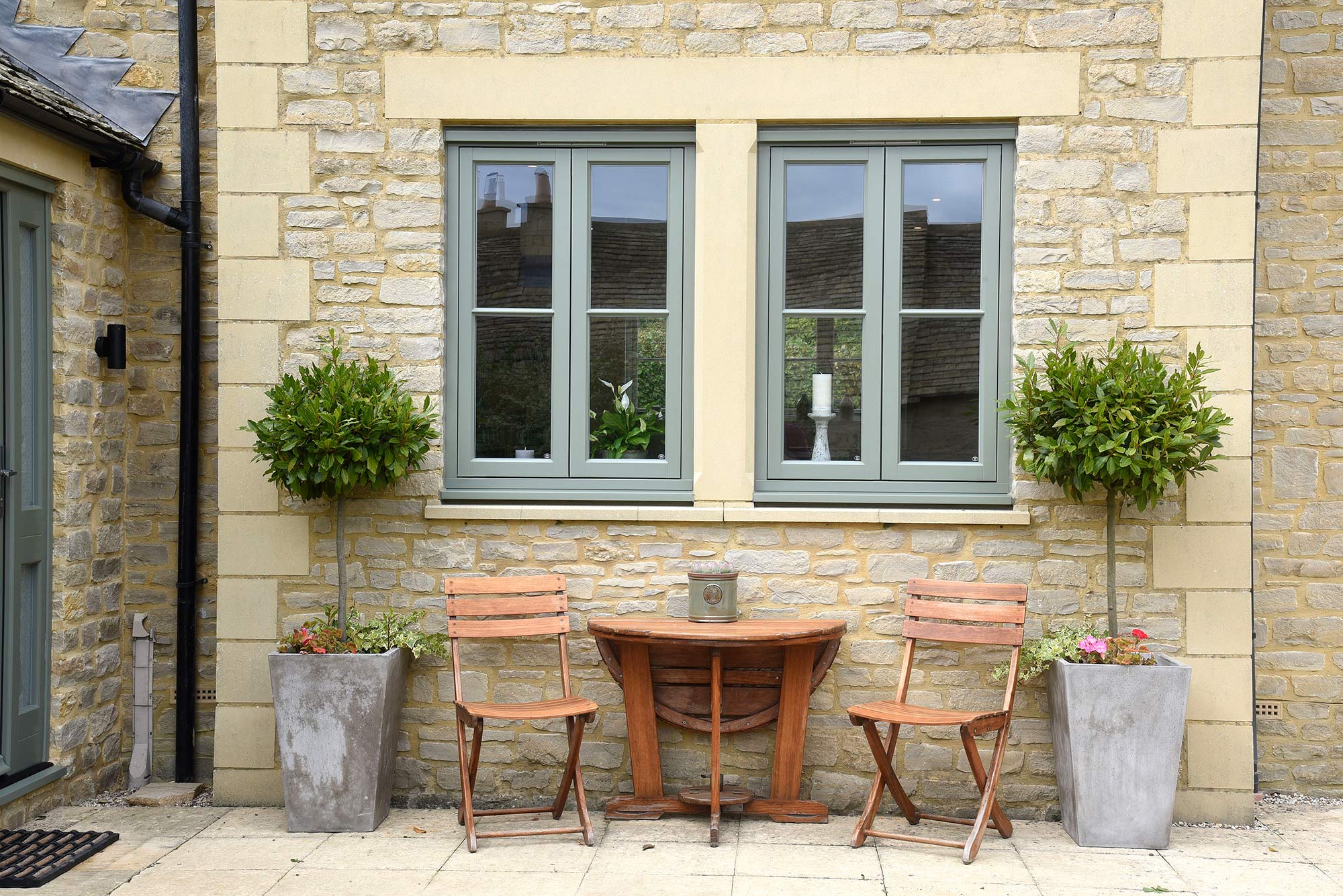
Today’s windows and doors are highly customisable, allowing homeowners to really show their personality, and allow their home to beam beautiful with a greater variety of choice when it comes to configuration, hardware, and colour.
Modern manufacturing and painting techniques mean fewer windows nowadays are the standard, traditional White, that you may be accustomed to seeing in homes of all styles and ages across the country, or see as a default colour in essence. In fact, at Timber Windows, less than half of the windows we manufacture are now specified in White. Shades such as French Grey have increased in popularity over the years, presenting a softer look to the home, while giving it character and kerb appeal.
However, with so many colour choices available, where do you start when it comes to looking at new windows and doors for your home? And what should you consider? Let’s take a look at some factors to consider below.
The property’s architecture and age
The look and architecture of your home is a good starting place when considering what style and colour you should opt for, for your new windows. Older properties, especially those in either conservation areas or protected with a Listed Status may be more restricted when it comes to choice, as preserving the building’s heritage and ensuring any changes are in keeping with both it, and the local area are key considerations that will affect whether new windows are approved. Most often, a like for like replacement of style are the most common occurrences in these situations and so this may lead to the colour being restricted as well.
When looking at different architectural styles and property façades, such as red brick, stone, cladding, render etc, this is a key factor to consider. As one of our customer’s succinctly worded it when we visited their beautiful Cotswolds cottage for a photoshoot, “Windows are so important to a house; they are the eyes”. Windows are often the first thing we naturally look at when looking at a property, and so you want to ensure they complement the façade of the building, and not contrast heavily where you can instinctively tell, it was not the right decision. If of interest, you can read more about that customer’s journey here.
On a traditional red brick home, pairing with White windows is a natural choice. However, modern tastes are shifting gradually away from this, timeless, yet stark colour, and opting more towards more subtle shades of Off-White, Cream, lighter Greys, French Grey Etc. These subtle, yet calming colours work perfectly against red brick and yet are not such strong colours that they contrast deeply against it.
For a converted barn, or modern cladded property, you would not expect to see white windows, however. Darker Anthracites, Black and traditional stain finishes are more popular choices here, working well with the cladding finish. For rendered / white stone or brick properties, the neutral white finish of the home will lean away from traditional white windows as there will be too much white where the windows would appear washed out. The neutral finish, and flexibility of colour matching with a white property façade here allows for more creativity, as almost every colour works well with white. This provides an opportunity to show your personality, providing it is in keeping with the home itself and still complementing it.
Consider the architecture of your home and neighbouring properties, and visualise what colours would, and especially wouldn’t, work.

Colour inspiration sources
Social media, especially Instagram and Pinterest can be key allies in providing inspiration and ideas for home renovations, and this is the same for choosing the right style and finish of your new windows. On Instagram, there are numerous property renovation accounts from all over the country. These range from a simple redecoration to a complete remodel on all sorts of property types. Browsing through accounts of homes that are similar to yours is a great way of getting inspiration for what worked for them. What style and colour did they choose for their windows? Would you have done the same or would you have chosen a different direction?
These accounts are also fantastic for sharing tips on how they went about it and what they would recommend, and are a great, community driven way of sharing advice, do’s and don’ts etc, that will be useful for your own home renovation.
Pinterest is a superb tool for building mood boards for any topic or interest you have. Building essentially a mini portfolio, or scrapbook in effect, of window styles, colours, configurations etc that you like, will help you narrow down what finishes you do and don’t like. Even if you are not consciously doing it, you will find that you are saving pins and ruling out other options as they do not appeal to you when they first appear on your feed.
Case studies, such as on our website, are also a wonderful tool. We have had the privilege of visiting properties of all sorts and sizes across the years from a wide variety of different eras. Browse through our archive here, which we are always adding to. Is there a property similar to yours here? And did the style and colour of these windows appeal to you?
Looking at your neighbour’s properties works in the same way, especially if they have recently had a renovation undertaken. It is so often we hear from our customers that they became aware of us via a neighbour or friend who had their windows and doors replaced by us, and the look was so transformative, they wanted the same for their home.
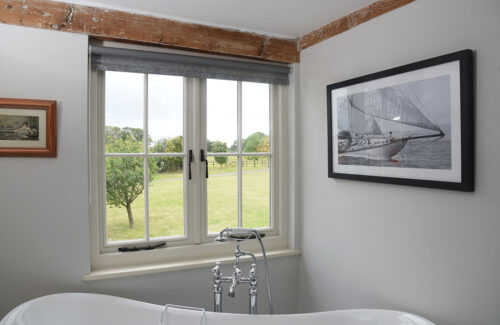
Trends
New windows and doors are a significant investment for your property, and one that will last for years to come, that will affect the overall look, and ultimately, value of your home. Therefore, make a choice that is reflective of your style and how you want your home to look, but one that will also complement and enhance your home and stand the test of time. Trends come and go and while this is easily rectified for a smaller renovation project such as wallpaper, or pieces of furniture; not so much for a major home renovation.
It is hard not to look back at the PVC boom in the 1980s when it first really took off in the UK market. It was undeniably, cost effective and a practical solution for homeowners at the time. However, typically white PVC front doors have not aged well with today’s trends, and in comparison to what is now available on the market, not just in terms of material, but also styles, colours and especially strength and security, look dated, and cheap by contrast.
It is understandable therefore that a lot of homeowners will play it safe when choosing the colour of their new windows. Like for like replacements are a popular choice; why change what was already working when you know it suited the appearance of the home? A bold colour such as greens and reds for example are popular choices with a new front door, but not so much windows, due to this much strong colour across the home risking being a bit garish. However, it brings us back to what we mention earlier about subtle, soft shades, that are not necessarily a traditional, pure white. Off-Whites, calm greys, cream etc are a way of achieving a traditional look, but with a subtle, modern twist that will not age and become unpopular in a way that a trendier, ‘out there’ colour may in years to come.
Make your house your home and show your personality
Your home is your pride and joy, and your personality should reflect in this. This extends not just to how it is decorated internally, but also how it appears from the outside. While we advise to be wary of trends, we also encourage you to make your house, your home. This could mean taking a property back to its roots, such as installing traditional Victorian sash windows on a Victorian terrace, where the previous owner opted for casement windows; or adding new life to a new property, giving it a completely new look and remodelling it from top to bottom.
This is an area where dual colouring can really shine. Gone are the days where a window could only be one colour. With the Timber Windows range, internally your window can be different to the external, and can fit in perfectly to how you have decorated the room, rather than being stuck with a colour that can be jarring with the wallpaper, or furniture for example. We had the pleasure of visiting a property in Cheshire a few years ago, which you can read about here, where they did exactly this in the home’s sitting room, opting for a colour complementary to Farrow and Ball ‘Down Pipe’ internally, matching the colour scheme of the room, while a traditional White was specified externally, complementing the red brick finish of the home. This was a true reflection of the homeowner’s vision and personality, putting their stamp on their forever home.
Colour options with Timber Windows
With the Timber Windows range, we offer an impressively, extensive range of colours. Beyond our own colour and stain palette, we can finish your new windows and doors in any RAL colour, as well as offer colours complementary to popular ranges from leading paint manufacturers such as Farrow & Ball, Fired Earth and Little Greene.
As mentioned, our case studies page can provide a wonderful source of inspiration for your home. You can read more about our full product range of casement windows, sash windows, front doors, bifold, French and patio doors, as well as our specialist Listed Buildings range for further inspiration. Our network of specialist showrooms across the country consist of local experts who can advise further, using their years of experience of working in your area, and on properties such as yours, and help you narrow down the options, to the ones that would be most suitable and work best for your home.
Whichever colour(s) you do decide to go for, with the Timber Windows range, this is backed by an impressive 12 year guarantee, and up to 6 years for stained finishes, giving you confidence and peace of mind with your new engineered timber windows and doors.


